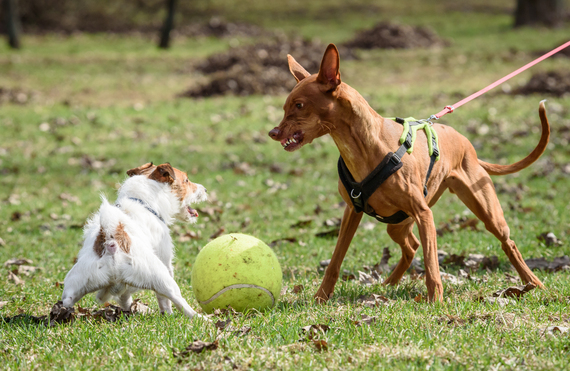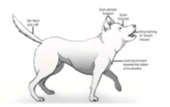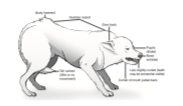If only I had a golden dog biscuit for the times I've heard the phrase "My dog is a bully" while out walking my dogs. Often hollered from the backend of a leash, people assume that the one who pulls the hardest, barks the loudest, and inflicts the most pain must be a real bully.
Or should I say, that people wrongly assume...
I'm here to set the record straight. When talking about dogs, or kids for that matter, aggression (aka bullying) is rarely a sign of strength or savvy. Real bullies are poorly socialized, insufficiently nurtured individuals who lack boundary control and the ability to process bad feelings.
Does that describe your dog? Probably not. Many leash aggressive dogs are pussy cats at home. So what gives?
To understand the nature of leash reactive dogs, learn how to interpret their communicative poses. Here is a sampling of the posture illustrations from my most recent book Modern Dog Parenting, Raising Your Dog or Puppy to Be a Loving Member of Your Family, St. Martins Press. Each one represents an emotional reaction: memorize these and you'll be able to translate what dog's think and feel.
Now consider what happens when you're out walking your dog.
From your perspective, leash walks are bonding time: an excellent way to get out and give your dog exercise.
Your dog doesn't always share your worldview, however. Strolling along tethered to the end of a 6-foot strap can get be monotonous and restrictive. Given the choice your dog, like all other dogs, would run along freely following a scented pathway, picking and choosing friends by her standard.
Although dogs can be conditioned to accept the restraint and learn to adapt to our social habits, if you haven't made the effort, chances are your dog has pulled you. And if you've been pulled, you've likely found yourself on the receiving end of what I affectionately call a CHW: A Canine Holy War.
What does that look like? CHWs may include any of the following:
- Stare downs
- Raised hackles
- Leash lunging
- Defensive barking
- Snarls and growls
- Leash spinning, often paired with redirected aggression toward you or another familiar dog
- An all out dog fight
To fully understand why dogs feel stressed during their leash walks you'd have to be a dog. The next best thing? Learn to think like them: I can help you there.
In the long, intertwined history of people and dogs, the leash and leash walking are relatively new inventions, designed for convenience and safety. Humans walk in straight lines, confident in the belief that they are in charge because they are holding the leash.
But restricted, linear movement is unnatural for dogs, who prefer to meander and explore. Dogs start out pulling on the leash to increase the meandering. Humans pull back to increase the restriction. This combination of straining to get away and pulling back puts pressure on the dog's collar or body, and in a response known as oppositional reflex, the dog pulls back. A feeling of entrapment causes the stress hormones to flow.
Put yourself in your dog's paws or imagine trying to do a similar thing to a child.
Dog's respond to anxiety the same way all mammals including people, do: they get frustrated or frantic. Some dog's pull harder, while others increase movement back and forth. Neither response reflects joy, and when forced into the personal space of another dog or person their stress skyrockets.
What does a dog do when their stress skyrockets? The same thing you'd do: they react. But dogs don't react as people do: they react like dogs do. Read the bulleted list above.
To rehabilitate your leash reactive or aggressive dog will take some effort on your part.
Step One: Off-Leash Control
Practice your first step off leash: Specifically indoors, and away from all distractions. Remember, if your dog doesn't prioritize your voice in the quiet of your home, she won't listen to you outside either.
Teach your dog to Follow, Stay, Watch and Find it- all directions and games you'll use on your walks. My book Modern Dog Parenting outlines positive lessons; my YouTube channel visualizes these routines too.
When you walk, move with enthusiasm. Fake it if you must. Walks are your dog's big adventure and he'll only alert to you if you reflect his excitement. Use treats, praise and toy play when introducing words: reward your dog's cooperation.
Step Two: Teach Your Dog ESL
Research now shows what dog parents have known for centuries: that dogs are communicating all the time, as well as responding to our reactions to their behavior. Sure they don't understand words: but they get the meaning by the tones we use.
To teach your dog to alert to words think of her like an ESL student (English as Second Language). Start with words that represent your daily routine, like inside, outside, car, and upstairs. Use a tone that's clear and directive: the kind you'd use when asking "Pass the Salt." Add hand signals and praise your dog for listening.
Step Three: Dress for Success
Before you use your new skills outside, equip your dog for success.
Be compassionate when choosing your dog's body wear. Many collars and harnesses restrain dogs ineffectively.
If your dog strains at the leash, you're using a poorly devised or fitted collar or harness. Flat or pronged collars can intensify leash aggression. Many dogs condition to the annoyance.
Test other collars or harness restraints. My favorites include the Gentle Leader, Easy Walk and other front clip harnesses.
Step Four: Positive Leash Conditioning
Before you set out with your new resolve, make sure you're using the right leash. Flexi-lease, while super for solitary field or beach meanderings, should not be used anywhere else. A sturdy 6-foot leash made of leather or nylon are ideal.
Hold the leash, like you would someone's hand: gently, gently. Relax your arm straight, and guide your dog back, using treats to sweeten the deal. If she lurches forward, calmly change direction or stop. Reward your dog with praise, treats or toys each time she looks up or cooperates with a direction.
Step Five: Leash Reactions
Before dogs are positively conditioned to their leash walks, many strain ahead, assuming a self-protective stance when they see something or someone who isn't immediately identifiable. When this happens too often, these same dogs start to scan the distant plains for strangers in their midsts. True, your suburban cul-de-sac may not resemble a dangerous wilderness, but old habits die hard.
Use happy talk, rewards and games like Find it to engage your dog as you walk with her. If you're approaching an unfamiliar person or animal, check your dog's reaction. If your dog is frightened or agitated, move away or pass by quickly.
Remember the goal is to walk with your dog, not tethered to her. Walks should bring about the calm you experience when walking hand-in-hand with someone you love. It is a learned habit: it takes some practice to get it right.
Read Modern Dog Parenting to learn some tips to get started. If you need coaching, find someone in your area or reach out to me for Skype or private lessons. If you nip your leash issues early on, they can often be addressed in a single session.
Now, the next time you experience leash aggression, reconsider it. It has as little to do with conscious decision making as your reaction would if I were to drag you along on a short tether and were to force your greeting strangers against your better judgment.
You don't have to delve deeper too deeply into the psychology of dogs to learn that dogs think, act, and relate much like a 2-3-year-old toddler. And whether you have children, you can certainly remember being one. Close your eyes and imagine having to explore your world, day after day, on the end of a short tether. What emotions would that leave you with?



